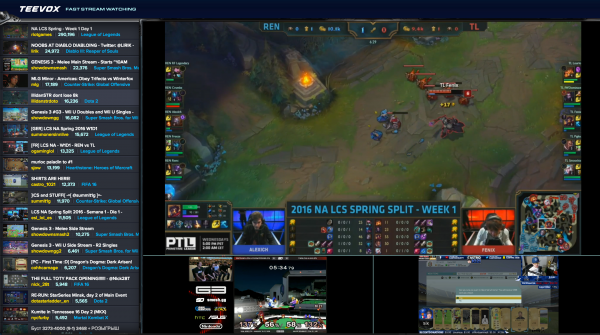Jong-Moon Kim, founder of Teevox, has resurrected his technology for Twitch. The programmer initially developed Teevox in 2011 to watch multiple eSports livecasts on Twitch, something that wasn’t available anywhere else. But that was still early days of the livestreaming explosion, and now Kim has brought a new version of Teevox to Twitch. He explains what this opens up for pro gamers and eSports in this exclusive interview.
What’s your eSports background?
I’ve been an avid gamer since my dad brought home a NES system when I was four. To my dad’s dismay, this escalated to a great deal of Starcraft playing during my high school years as any self-respecting full-blooded Korean gamer can attest to. When I discovered people were playing Starcraft professionally, it was an incredible moment—the thrill of watching someone using blinding dexterity to accomplish impossible feats had me hooked for life.
Why did you initially launch Teevox in 2011?
2011 was the year of Starcraft streaming. It was the Woodstock of eSports. A perfect brew of talent, audience and technology came together to make the industry explode. At that time, I had been working on a video transcoding startup (where Teevox got its namesake) and after long hours of coding, I would relax by pulling up Starcraft streams. What I loved aboutStarcraft streams was the fact that you still got the thrill without the draining mental workout.
The problem was there would be huge Starcraft tournaments running simultaneously. At the time, the largest tournaments were IPL (IGN Pro League) and NASL (North American Starcraft League). I remember juggling four different tabs and manually muting and unmuting streams until I realized this was rather stupid.
The project started off as a side curiosity, seeing if there was a way to control streams programmatically. Once I realized that was possible, I spent a month polishing the product into something usable. I decided to name the site after a Starcraft unit called the Warp Prism. I thought it was appropriate considering it was a unit that would teleport useful units to the frontline of battle.
It became an instant hit, reaching the front page of Reddit. That was the start of this strange journey. Through the months I released updates. I changed the name to Teevox to help adapt it across other games as well. An Android app was released to wide acclaim and I developed a novel remote control for your phone to control Teevox on your computer.
What differentiates this new product from anything else out there?
In a word, it’s fast. Unlike sites belonging to eSports organizations or other gaming destinations, it just has one focus — deliver what you want to watch in the shortest amount of time possible.
The uniqueness stems from the novel technology that was developed to carry out that mission. Teevox was a pioneer in techniques of stream preloading and variable bitrate control to provide a seamless experience.
Now on the surface, the product seems as simple as ever. I remember it was nearly every day someone on Reddit would write, “Isn’t this just embedding with copying and pasting?” And then someone would always jump in, “Just try it man.”
Teevox went to great lengths to hide the complexity underneath, presenting a simple, intuitive product.
What type of user base did you have back then?
At its peak, Teevox had 700,000 monthly users. Teevox grew substantially during the summer months as Starcraft tournaments were lined up back to back.
Why did you decide to shutter the product in 2012?
After strong growth through 2011 and the beginning of 2012, the product started faltering. I had tried to launch other product lines and created partnerships to increase viewership, but it was coming up short. It had gone through seven months of stagnation and I wasn’t sure how to make it grow further. It was very demoralizing to see your graph start trending downwards.
The scene had become very crowded since Teevox’s first release. A number of other organizations had launched Teevox-like products under their own brands and we were all competing for a fraction of the tiny viewership back then.
After hemorrhaging money for an extended period of time, I felt the future looked bleak for Teevox to ever become something self-sustainable. I still regret having let go of the product and letting down its fans.
Why did you decide to relaunch this year?
After attempting two dozen different startup ideas since then, none of which worked out, I was about to close up shop and start looking for gainful employment. I started shuttering the corporate accounts. When I opened up Teevox’s Facebook and Twitter accounts, years worth of old messages poured out from fans missing Teevox. These messages were from 2013 through 2015.
How many products do you really remember after it’s gone away for three years? That made me realize the product was something really special. The fans didn’t just like the product, but loved it in a way I didn’t realize before.
That gave me the energy to do a final push before giving up on startups entirely. I’ve spent the past few months polishing the new Teevox to be something worthy to be called its successor. I’ll have to admit, my development skills had improved dramatically over the past three years. The 2016 Teevox is sleeker, faster, and more powerful than I could’ve imagined possible in 2012.
What’s changed in terms of business opportunities for Teevox today?
The eSports world today is vastly different from the 2011 world. Back then, we were lucky to hit 15 million viewers each month across the industry. Today, that number is over 200 million. Just this past year Twitch recorded 1.5 million streamers. If you can imagine having 1.5 million channels to watch on TV, that’s not a challenge for the feint-hearted.
I remember being annoyed in 2011 with having to deal with a single tournament and one other streamer. Today, it’s not uncommon to see five or six simultaneous tournaments happening across the world on a weekend with a few dozen streamers you’d like to tune into.
The problem has magnified into something intolerable, pushing the upper limits of viewer content overload. I believe this is a crucial issue for the industry as it will look for solutions to bolster its meteoric growth. Teevox aims to be the technological partner in blunting this pain, allowing eSports organizations and players to focus on what they do best: capturing exhilarating moments you can’t get anywhere else.
One of the most dramatic shifts is the fact that Twitch is no longer the tiny upstart. After its $1 billion acquisition by Amazon, it heralded a new era, becoming the bedrock platform for new businesses to be built on top.
As a foundational pillar of eSports, Twitch is rapidly becoming the new Hollywood. Teevox aims to be the Samsung to Twitch’s Hollywood, providing viewing technology to further enhance the inimitable content from Twitch.
It’s not every day you get a brand new multi-billion dollar industry with pristine opportunities for the picking.

What’s your business model?
The Teevox viewing engine will be licensed out to tournaments, eSports organizations, and individual streamers, bringing the incredible experience you get at https://teevox.com to their personal and corporate domains. I believe this model fits very well with Teevox’s core competency and novel technologies that were developed in-house.
How big an audience do you see for this product today with the rise of live streaming?
With eSports having a global audience of 200 million, Teevox has a lot of headspace to grow if it can make its mark as a powerful viewing platform. One advantage in this industry is the fact that the platform is globalized from Day 1. Surprisingly, gaming is one of the most uniting forces across national lines. A Starcraft game has no language other than the action happening on the screen. This has led to tournaments being able to be spread widely across the world, giving a massive store of entertainment as a (mixed) blessing. The industry as a whole is going through a growth spurt, making this a key window to make things happen.
Do you work directly with Twitch in any way?
They had tried to hire me back in 2012. I admit, that would’ve been the smart decision. I remain friends with them, and it also helps that we are both Y Combinator companies. We are not collaborating on Teevox in a formal capacity.
Will this app work with other live streaming services like Azubu or YouTube?
The current focus is to build out the complete product on top of a single platform. Twitch happens to be the most established and with our ties going way back to 2011, I believe it made the most sense to start with them. Once the core has been established, I’ll take stock of what the community would like as next steps. If there is great demand, Azubu and YouTube can be integrated.
Are you working with any established eSports leagues, and if not what opportunities do you see there?
For eSports organizations, I believe investment in viewing technologies constitute some of their most highly leveraged dollars. I see event organizers spending inordinate amounts of effort creating a beautiful physical stage and in-person experiences. But online, they use a copy-pasted embed that’s unremarkable, replaceable, and forgettable. With the bulk of their audience coming remotely, I believe improving the online branded experience can do wonders for their events.
What does this app open up for advertisers or sponsors?
For Teevox-licensed players, organizations can develop a powerful solution that presents their content in a compelling way, as well as ensuring their sponsors deliver their message.
For the Teevox.com player for fans, I don’t foresee having outside advertisers. There may be in-house opportunities to help streamers increase viewership, but that would be a hypothetical way down the line.
How will Teevox be marketing this relaunch?
The challenge will be to let the original Teevox fans know that it’s coming back. Three years is a long time, as most communities dissipate after a while. Efforts will be made to reconnect with them through Reddit, Twitter, and Facebook.
 Simon Carless, Executive Vice President of The Game Developers Conference (taking place March 14-18 in San Francisco), talks to [a]listdaily in-depth about the survey findings and how this year’s conference will heavily feature VR and eSports themes.
Simon Carless, Executive Vice President of The Game Developers Conference (taking place March 14-18 in San Francisco), talks to [a]listdaily in-depth about the survey findings and how this year’s conference will heavily feature VR and eSports themes. When asked which VR/AR devices interested developers most, the survey results broke down as follows:
When asked which VR/AR devices interested developers most, the survey results broke down as follows:





 “If you want to achieve a great growth on Instagram, you do need to consider alternative tactics,” the report explains. “Organic growth will not get you far.” It also makes note that influencer outreach is very much worth considering, especially now that advertising is open across the board on the site. Artists like Skrillex, Diplo and others
“If you want to achieve a great growth on Instagram, you do need to consider alternative tactics,” the report explains. “Organic growth will not get you far.” It also makes note that influencer outreach is very much worth considering, especially now that advertising is open across the board on the site. Artists like Skrillex, Diplo and others 





